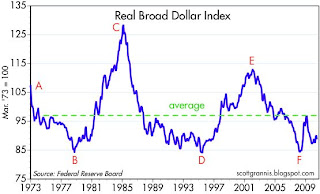A Brief History of the Dollar
Calafia Beach Pundit submits:
Here, in a nutshell, is my version of the history of the dollar's history, with a focus on its major turning points. As a point of reference, I'm using the Fed's Real Broad Dollar Index (chart above), which measures the dollar's value against a large basket of trade-weighted currencies, all adjusted for changes in relative inflation. It's arguably the best measure of the dollar's true value against other currencies. I've marked 6 key turning points in the dollar, and I explain here the key events occurring around the time of each turning point. I also opine on the future of the dollar.
A: Most measures of the dollar's value only go back to 1973. That's unfortunate, since the modern history of the dollar begins in August 1971, when Nixon ended the dollar's convertibility into gold. Prior to that point, the dollar had been fixed to gold at $35/oz. since 1934, and most of the world's currencies were pegged in some fashion to the dollar. Nixon's decision to abandon the gold standard was the catalyst for what would eventually prove to be a major devaluation of the dollar. The underlying cause of the dollar's collapse, however, was the Fed's decision to ease monetary policy in support of Great Society spending programs. The Fed's easy money policy started in the mid-1960s, and it was reflected in a steadily increasing outflow of gold. The Fed was holding interest rates at artificially low levels, and this was undermining the world's confidence in the dollar. Central banks began demanding gold in exchange for their dollar holdings, until Nixon's decision put an end to that. That decision effectively relieved the Fed of the need to raise interest rates significantly, which in turn exposed the fact that there was a huge excess supply of dollars in the world.
Complete Story
Here, in a nutshell, is my version of the history of the dollar's history, with a focus on its major turning points. As a point of reference, I'm using the Fed's Real Broad Dollar Index (chart above), which measures the dollar's value against a large basket of trade-weighted currencies, all adjusted for changes in relative inflation. It's arguably the best measure of the dollar's true value against other currencies. I've marked 6 key turning points in the dollar, and I explain here the key events occurring around the time of each turning point. I also opine on the future of the dollar.
A: Most measures of the dollar's value only go back to 1973. That's unfortunate, since the modern history of the dollar begins in August 1971, when Nixon ended the dollar's convertibility into gold. Prior to that point, the dollar had been fixed to gold at $35/oz. since 1934, and most of the world's currencies were pegged in some fashion to the dollar. Nixon's decision to abandon the gold standard was the catalyst for what would eventually prove to be a major devaluation of the dollar. The underlying cause of the dollar's collapse, however, was the Fed's decision to ease monetary policy in support of Great Society spending programs. The Fed's easy money policy started in the mid-1960s, and it was reflected in a steadily increasing outflow of gold. The Fed was holding interest rates at artificially low levels, and this was undermining the world's confidence in the dollar. Central banks began demanding gold in exchange for their dollar holdings, until Nixon's decision put an end to that. That decision effectively relieved the Fed of the need to raise interest rates significantly, which in turn exposed the fact that there was a huge excess supply of dollars in the world.
Complete Story
A Brief History of the Dollar
https://blogger.googleusercontent.com/img/b/R29vZ2xl/AVvXsEjYxDjFUf_c6oeNNdKQnrdRle3D82T8VYtKBHFbcb_Yv6DCCh2MwtMQ1jvqRiaDMzwYLrFSFdbto-_pwdfW7WZNH2JrYy7gWSVk6p6hkCy9EBmBgCTAMKUgSIFDBRfnZF8y5MsWtw3NNsU/s1600/Real+Broad+Dollar+Index-- The MasterFeeds

